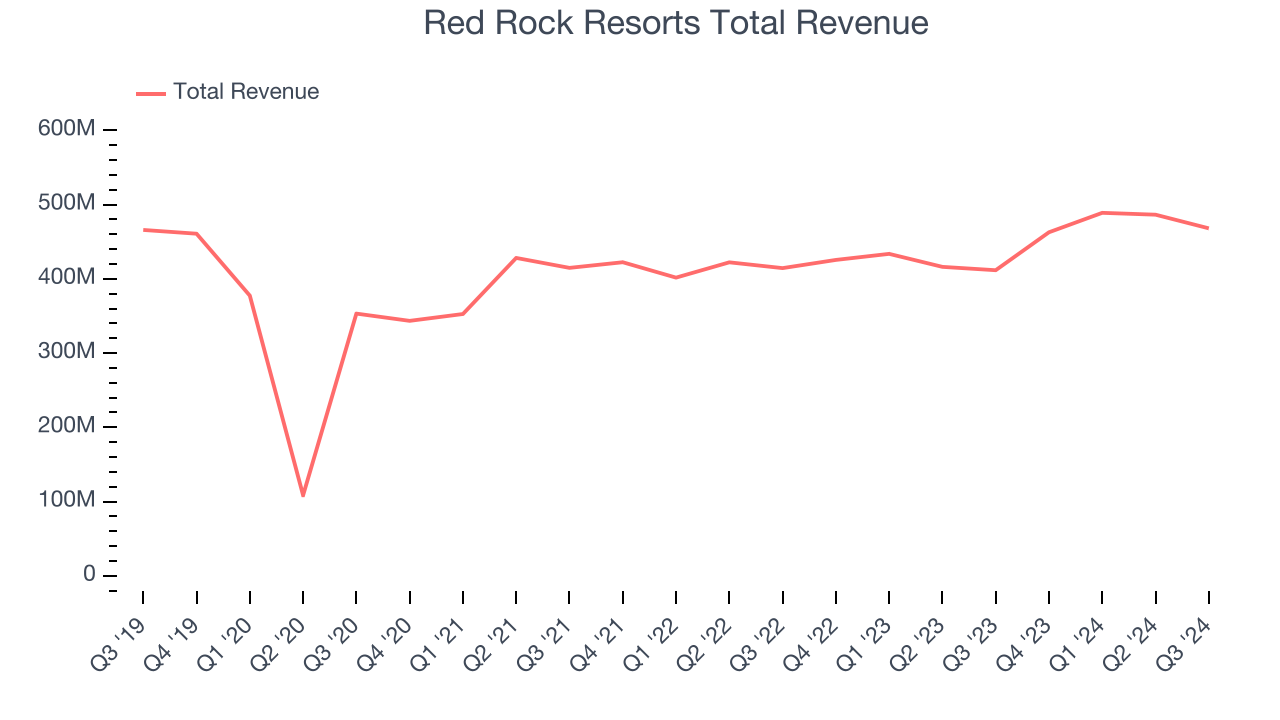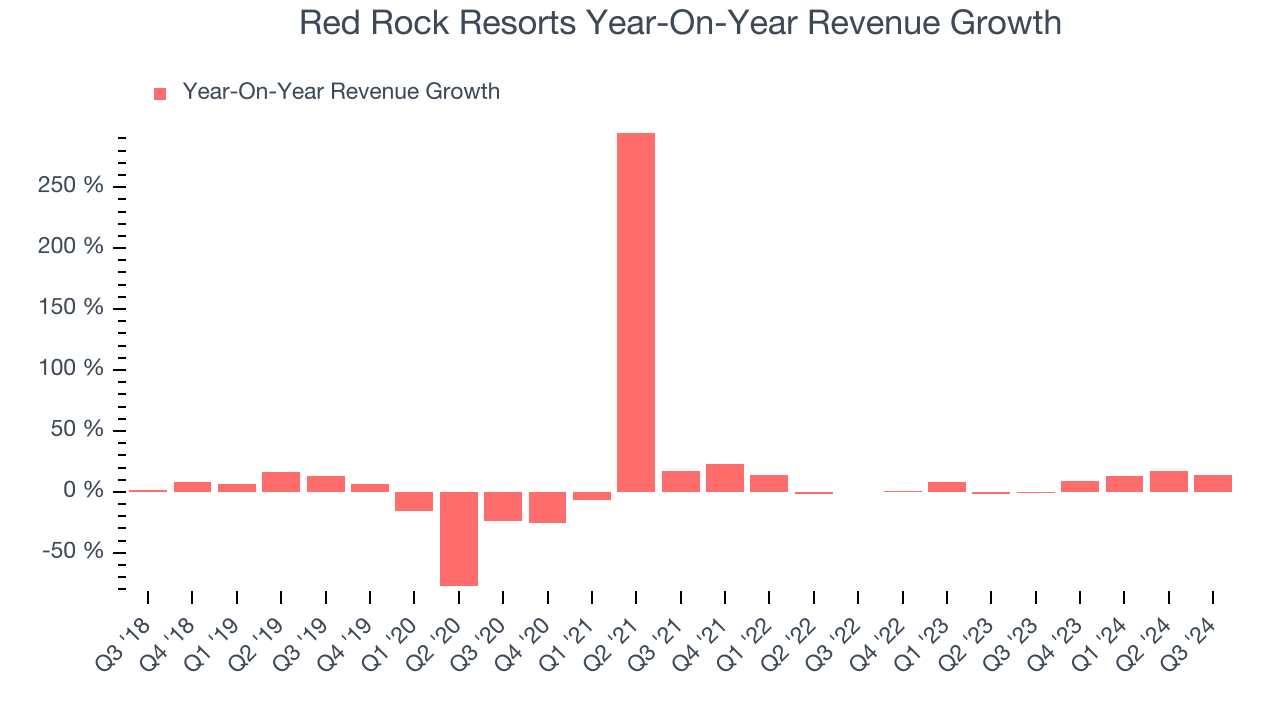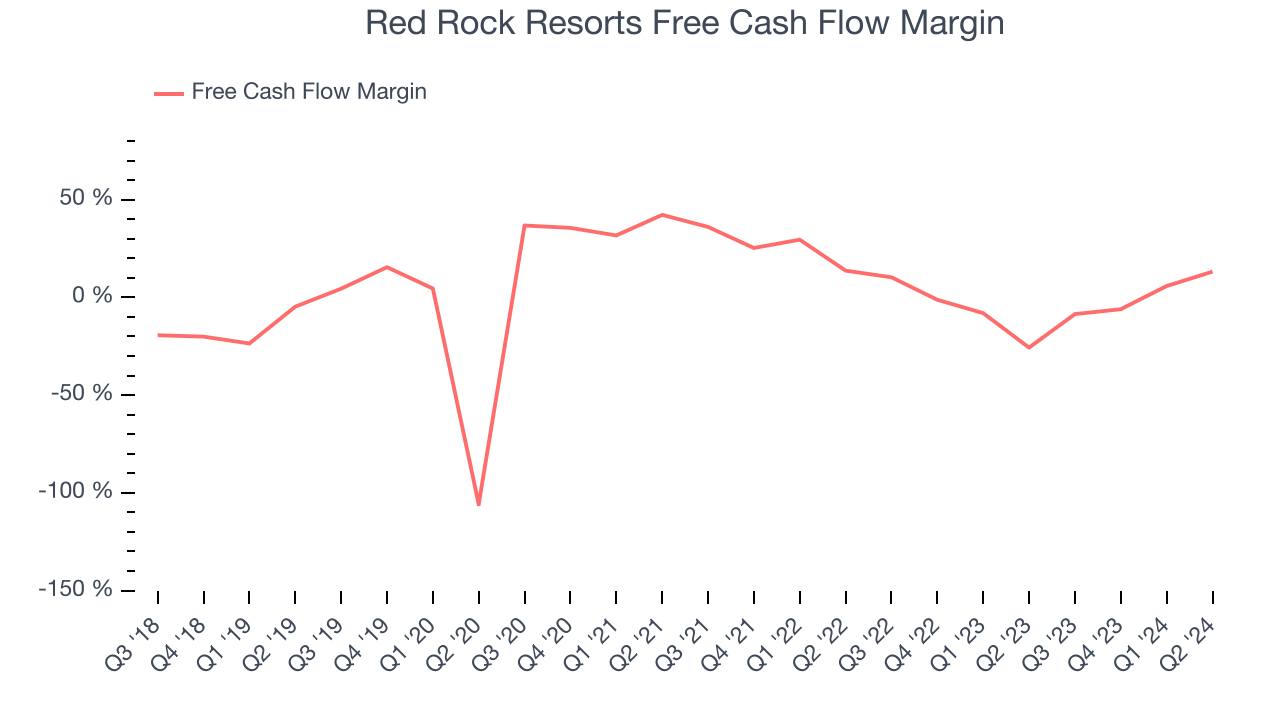
Casino resort and entertainment company Red Rock Resorts (NASDAQ:RRR) beat Wall Street’s revenue expectations in Q3 CY2024, with sales up 13.7% year on year to $468 million. Its GAAP profit of $0.48 per share was also 31.2% above analysts’ consensus estimates.
Is now the time to buy Red Rock Resorts? Find out by accessing our full research report, it’s free.
Red Rock Resorts (RRR) Q3 CY2024 Highlights:
- Revenue: $468 million vs analyst estimates of $460.9 million (1.5% beat)
- EPS: $0.48 vs analyst estimates of $0.37 (31.2% beat)
- EBITDA: $182.7 million vs analyst estimates of $185.9 million (1.7% miss)
- Gross Margin (GAAP): 60.8%, down from 63.7% in the same quarter last year
- Operating Margin: 27.9%, down from 29.9% in the same quarter last year
- EBITDA Margin: 39%, down from 42.6% in the same quarter last year
- Market Capitalization: $3.34 billion
Company Overview
Founded in 1976, Red Rock Resorts (NASDAQ:RRR) operates a range of casino resorts and entertainment properties, primarily in the Las Vegas metropolitan area.
Casino Operator
Casino operators enjoy limited competition because gambling is a highly regulated industry. These companies can also enjoy healthy margins and profits. Have you ever heard the phrase ‘the house always wins’? Regulation cuts both ways, however, and casinos may face stroke-of-the-pen risk that suddenly limits what they can or can't do and where they can do it. Furthermore, digitization is changing the game, pun intended. Whether it’s online poker or sports betting on your smartphone, innovation is forcing these players to adapt to changing consumer preferences, such as being able to wager anywhere on demand.
Sales Growth
A company’s long-term performance is an indicator of its overall business quality. While any business can experience short-term success, top-performing ones enjoy sustained growth for multiple years. Red Rock Resorts’s demand was weak over the last five years as its sales were flat, a poor baseline for our analysis.

We at StockStory place the most emphasis on long-term growth, but within consumer discretionary, a stretched historical view may miss a company riding a successful new product or emerging trend. Red Rock Resorts’s annualized revenue growth of 7.1% over the last two years is above its five-year trend, but we were still disappointed by the results. Note that COVID hurt Red Rock Resorts’s business in 2020 and part of 2021, and it bounced back in a big way thereafter. 
Red Rock Resorts also breaks out the revenue for its three most important segments: Casino, Dining, and Hotel, which are 67.1%, 17.8%, and 9.7% of revenue. Over the last two years, Red Rock Resorts’s revenues in all three segments increased. Its Casino revenue (Blackjack, Poker) averaged year-on-year growth of 5.5% while its Dining (food and beverage) and Hotel (overnight stays) revenues averaged 12.9% and 11%.
This quarter, Red Rock Resorts reported year-on-year revenue growth of 13.7%, and its $468 million of revenue exceeded Wall Street’s estimates by 1.5%.
Looking ahead, sell-side analysts expect revenue to grow 4.6% over the next 12 months, a slight deceleration versus the last two years. This projection is underwhelming and shows the market thinks its products and services will face some demand challenges.
When a company has more cash than it knows what to do with, buying back its own shares can make a lot of sense–as long as the price is right. Luckily, we’ve found one, a low-priced stock that is gushing free cash flow AND buying back shares. Click here to claim your Special Free Report on a fallen angel growth story that is already recovering from a setback.
Cash Is King
Although earnings are undoubtedly valuable for assessing company performance, we believe cash is king because you can’t use accounting profits to pay the bills.
Over the last two years, Red Rock Resorts’s demanding reinvestments to stay relevant have drained its resources. Its free cash flow margin averaged negative 3.8%, meaning it lit $3.78 of cash on fire for every $100 in revenue. This is a stark contrast from its operating margin, and the investments (working capital, capital expenditures) are the primary culprit.

The company’s cash burn increased from $35.19 million of lost cash in the same quarter last year.
Key Takeaways from Red Rock Resorts’s Q3 Results
We were impressed by how significantly Red Rock Resorts blew past analysts’ EPS expectations this quarter. We were also happy its revenue narrowly outperformed Wall Street’s estimates. Overall, we think this was a decent quarter with some key metrics above expectations. The stock remained flat at $55.66 immediately following the results.
Red Rock Resorts had an encouraging quarter, but one earnings result doesn’t necessarily make the stock a buy. Let’s see if this is a good investment. If you’re making that decision, you should consider the bigger picture of valuation, business qualities, as well as the latest earnings. We cover that in our actionable full research report which you can read here, it’s free.
